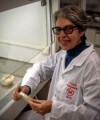Actualidad
Wuyiencin Reduces the Virulence and Patulin Production of Blue Mold
Wuyiencin reduces the virulence and patulin production of Penicillium expansum, the causal agent of blue mold, by interfering with its membrane integrity and the patulin synthesis pathway
Penicillium expansum (Ascomycota) is a destructive necrotrophic plant pathogen. It can develop at low temperatures and infect plant tissues through wounds, causing fruit decay. It infects various species, primarily apples, causing blue mold.
Blue mold is a serious economic problem in the fruit industry, responsible for up to 10% of fruit spoilage during storage.
In addition to fruit decay, P. expansum infection is often associated with the production of patulin, a mycotoxin that has genotoxic, mutagenic, immunosuppressive, and neurotoxic effects.
Prolonged consumption of apple juice and fruit products contaminated with patulin poses a health risk to humans. The European Union has set a maximum tolerance level for patulin of 50 µg/kg for fruit juices and their derivatives, 25 µg/kg for solid apple products, and 10 µg/kg for food for babies and young children (EC Commission Regulation, 2006).
Alternatives to Traditional Fungicides
In recent years, synthetic fungicides have been the main method of controlling blue mold. However, they induce fungal resistance and reduce disease control efficacy. Moreover, the excessive use of these fungicidal substances poses a potential threat to human health and the environment. Therefore, researchers have begun evaluating other promising approaches to control blue mold caused by P. expansum, such as the application of salicylic acid, chitosan, UV-C light, 1-octen-3-ol, and methyl jasmonate.
Biocontrol is an effective strategy for controlling blue mold disease, which can also reduce patulin production. The yeast Cryptococcus laurentii combined with the bacterium Kosakonia radicincitans has been reported to be effective in controlling P. expansum and reducing patulin.
Although biocontrol strategies are effective, they are difficult to use on a large scale due to the survival of viable microorganisms. The use of their active metabolites is more stable than the direct application of strains.
Wuyiencin, a Biocontrol Agent
Wuyiencin is a secondary metabolite produced by Streptomyces albulus var. Wuyiensis; it is a nucleoside antibiotic that was first isolated in the Wuyi Mountains in China. It is effective in controlling multiple pathogenic fungi in various fruits and vegetables, such as the gray mold of tomatoes caused by Botrytis cinerea, and the powdery mildew of cucumber and strawberry induced by Sphaerotheca fuliginea. Compared to traditional chemical fungicides, wuyiencin is environmentally friendly and non-toxic to humans and animals.
Due to its high efficacy and low toxicity, wuyiencin is produced industrially and widely used to control fungal diseases.
A recent study investigated the effects of wuyiencin on the virulence and inhibition of patulin production by P. expansum, as well as the possible mechanisms through transcriptome analysis, RT-qPCR, staining methods, and detection of cellular leakage, thereby providing a basis for the postharvest application of wuyiencin.
It was verified that wuyiencin inhibits spore germination and thus the development of mycelium, the virulence, and the production of patulin by P. expansum. A large number of fungal genes encoding membrane proteins are upregulated and expressed. However, the genes encoding membrane-bound organelles are downregulated under wuyiencin treatment.
Thus, the integrity of the cell membrane is destroyed. Additionally, the expression of some genes related to patulin synthesis and protein translation/processing is altered.
These results suggest that wuyiencin effectively controls the development of P. expansum.
Chemical Structure of Patulin
Chemical Structure of Wuyiencin
Octenol is produced by various plants and fungi, including edible mushrooms and lemon balm. Octenol is formed during the oxidative degradation of linoleic acid.
Sources
-
Li, H.; Wu, W.; Shen, X.; Zhang, W.; Wang, K.; Wang, Y. (2024). Wuyiencin reduces the virulence and patulin production of Penicillium expansum by interfering with its membrane integrity and the patulin synthesis pathway. Postharvest Biology and Technology, 212: 112857. Link to article
-
Yang, M.; Wei, Q.; Shi, L.; Wei, Z.; Lv, Z.; Asim, N.; Zhang, K.; Ge, B. (2021). Wuyiencin produced by Streptomyces albulus CK–15 displays biocontrol activities against cucumber powdery mildew. Journal of Applied Microbiology, 131(6): 2957–2970. Link to article
Images
Patulin image accessed from Wikipedia on 31/05/2024.













